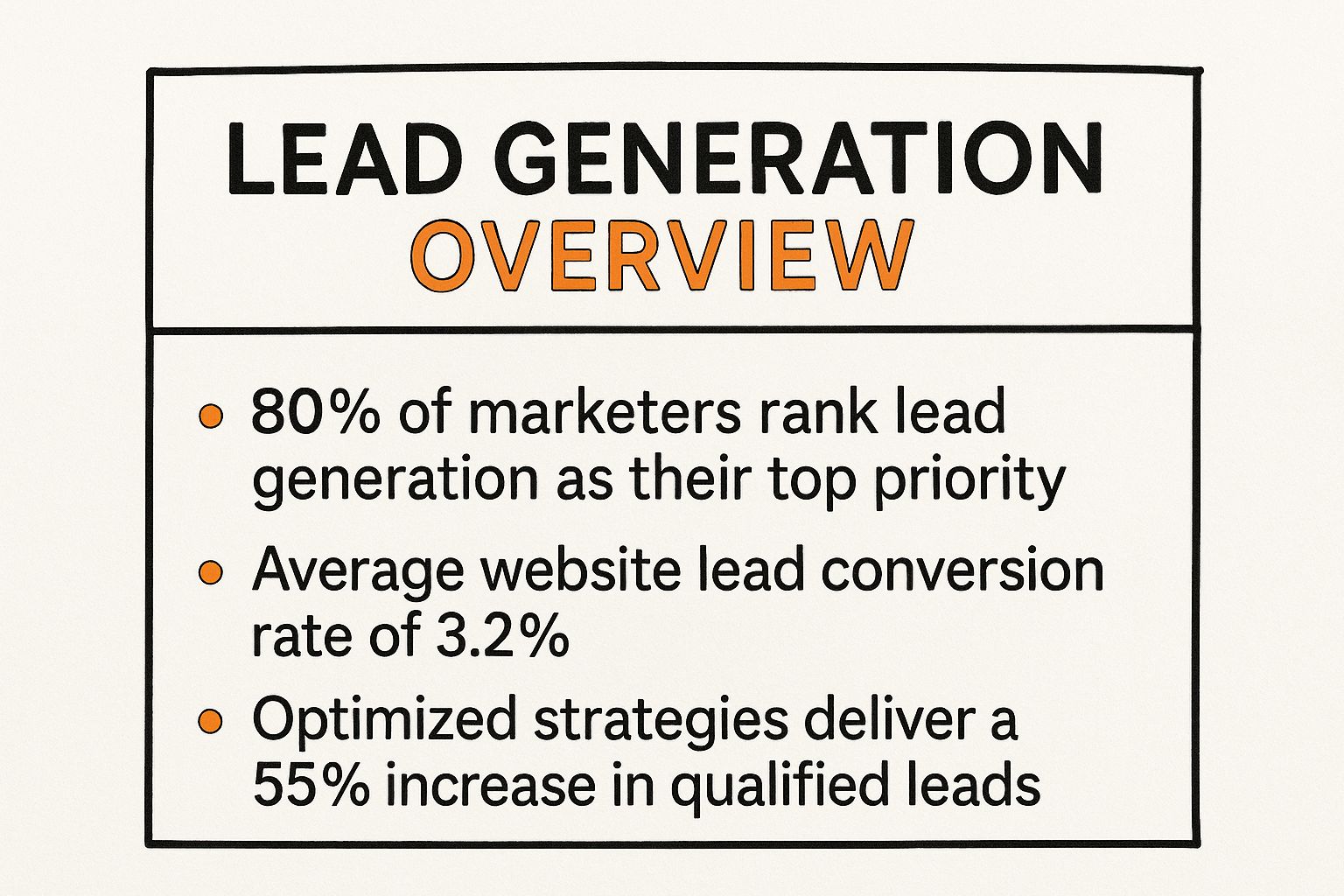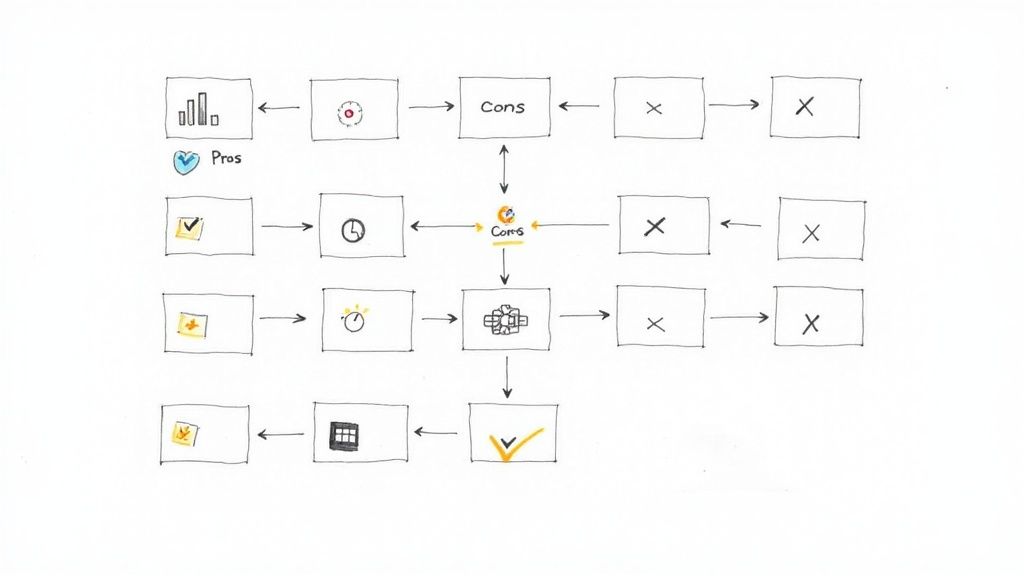If you want to generate more leads, you need a solid system. It's really that simple. This isn't about some secret hack or a single magic bullet. It’s about building a repeatable process that combines a high-quality prospect list, outreach that actually offers value, and a smart, persistent follow-up strategy. That's how you turn strangers into genuinely interested prospects.
The Modern Framework for Consistent Lead Generation
Chasing inconsistent lead flow is exhausting. We've all been there. The only way to break that boom-and-bust cycle is to stop hunting for one-off tactics and start building a reliable framework. A powerful lead generation engine isn't built on luck; it's engineered with a systematic approach that turns your effort into predictable results.
This structure is what separates sputtering, unpredictable campaigns from a system that consistently fuels your growth. And it all starts with getting crystal clear on who you're actually talking to.
Defining Your Ideal Customer
Before you write a single email or make a single call, you absolutely have to know who you're trying to reach. This is where your Ideal Customer Profile (ICP) comes in. An ICP is a super-detailed description of the company that gets the most value from what you sell.
We're not just talking about industry and company size. A great ICP includes firmographic data like:
- Revenue
- Technology stack they use
- Geographic location
Getting this specific prevents you from wasting time, money, and energy on prospects who were never going to be a good fit in the first place.
Once you know the company you're targeting, you can drill down to the buyer personas within those companies—the actual people making the decisions. You need to understand their roles, their daily headaches, and their biggest pain points. This is the key to crafting a message that actually resonates instead of just getting deleted.
A well-defined ICP is the compass for your entire lead generation strategy. Without it, you're just navigating in the dark, hoping to stumble upon a good lead. With it, every action has a purpose and a much higher chance of success.
This focus is non-negotiable because the competition for attention is fierce, and the financial investment is real. On average, organizations generate 1,877 leads per month, with the average cost per lead across all industries hitting $198.44. You can discover more key lead generation statistics to see just how much these numbers impact marketing budgets.
To help put things in perspective, this infographic breaks down just how critical—and challenging—lead generation is for most businesses.

The data makes it pretty clear: while generating leads is a top priority for 80% of marketers, the average website only converts about 3.2% of its visitors. That's a massive gap, and it's exactly where a smart, optimized strategy can make all the difference.
Core Components of a Modern Lead Generation Framework
Building a reliable lead generation engine requires several pillars working in tandem. This table breaks down the essential components that form the foundation of a modern, effective strategy.
Each piece builds on the last. A strong ICP leads to better lists, which enables more effective outreach, which is then amplified by a persistent follow-up game. Get these fundamentals right, and you're well on your way to building a predictable pipeline.
Building a Prospect List That Actually Converts
Let's be blunt: your outreach is only as good as the list you're sending it to.
If your list is inaccurate or poorly targeted, you’re just buying a one-way ticket to the spam folder. It’s the fastest way to tank your sender reputation and waste countless hours. So, forget about buying those generic, off-the-shelf lists. Building a high-quality prospect list from scratch is the single most important step for any outreach campaign that actually gets results.

The foundation of a killer list isn't just a jumble of names and emails. It's a carefully curated group of people who perfectly match your Ideal Customer Profile (ICP) — a detailed picture of the exact company that gets the most value from what you sell.
Start by Analyzing Your Best Customers
So, how do you build this ICP? Simple. Look at your existing customers.
Who are the happiest ones? The ones with the highest lifetime value? Who renewed their contract without even blinking? Find the common threads that tie them all together.
Drill down into these key firmographic data points to find the patterns:
- Industry or Niche: Are they all in SaaS, e-commerce, or another specific sector?
- Company Size: How many employees do they usually have? Is there a sweet spot?
- Annual Revenue: Do they tend to fall into a common revenue bracket?
- Technology Stack: Are they using complementary software like Salesforce or HubSpot?
- Geographic Location: Are they clustered in specific regions or countries?
This exercise gives you a data-backed blueprint. Now you know exactly what kind of company to hunt for, which is the first real step toward generating leads that have a high chance of closing.
Finding and Sourcing the Right Contacts
With your ICP locked in, it's time to find the actual people. This isn't a guessing game; it's a targeted search. Instead of aimlessly scraping websites, you need to use professional tools to pinpoint the right contacts inside your ideal companies.
LinkedIn Sales Navigator is an absolute powerhouse for this. You can plug your ICP criteria directly into its advanced search filters. For instance, you could search for "Marketing Directors" at "Software companies" with "51-200 employees" located in the "United States" who have "posted on LinkedIn in the last 30 days." That level of precision is how you find active, relevant decision-makers who are actually listening.
Beyond LinkedIn, don't sleep on niche industry directories and association member lists. These can be goldmines for sourcing highly relevant prospects that broader tools often miss.
Your goal isn't to build the biggest list; it's to build the right list. A tight list of 100 highly qualified, verified prospects who perfectly match your ICP will always demolish a spray-and-pray list of 10,000 generic contacts.
The Final and Most Critical Step: Verification
Okay, so you've sourced a contact. You're not done. This last step is the one most people skip, and it's a campaign killer: verifying their email address.
An unverified email has a high probability of bouncing. Every bounce hammers your sender reputation, making it harder and harder for your emails to land in any inbox, let alone the right one.
Using a dedicated email verification tool isn't a "nice-to-have"—it's essential. These services check if an email address is valid and can receive mail before you hit send. Aim for a clean list with a bounce rate under 3%. This meticulous final check ensures your messages get delivered, giving your campaign a real fighting chance to succeed.
Let's be real for a minute: most cold emails are just awful. They're generic, completely self-serving, and get deleted on sight because they completely miss the mark with the person on the other end. If you want to actually generate leads from your cold outreach, you have to do better than the noise. The secret isn't some magic template—it’s making every single email about them, not you.
Email is a workhorse for a reason. Around 78% of companies lean on it for lead generation, and you can see how it stacks up against other channels for yourself. The trick is to make your messages feel valuable and personal, not like they came off an assembly line.
Subject Lines and Opening Hooks
Your subject line has one job and one job only: get them to open the email. It needs to spark just enough curiosity to earn a click, but without straying into clickbait territory that kills trust before you even start. Ditch the generic stuff like "Quick Question" or "Checking In."
Instead, get specific and hint at the value you're bringing.
- Bad Example: "Intro"
- Good Example: "Idea for PlusVibe's Q3 content"
See the difference? The second one shows you’ve done a bit of homework. Your opening line is just as critical. It has to connect with their world immediately. Mention a recent LinkedIn post they wrote, a company milestone, or a shared connection. This is your proof that the email isn't just another blast to a faceless list.
Your opening line is your first impression. If it reads like a template, your email is already destined for the trash folder. Make it specific and relevant to prove you've invested time in understanding the prospect before asking for theirs.
Framing Your Value Proposition
Once you've got their attention, you have a tiny window to explain why you're in their inbox. This is where most people mess up. Don't just list your features. Instead, frame what you do as a solution to a problem you know they have.
To really nail this, you have to connect your solution to their reality. For example, instead of saying, "Our tool automates outreach," you could try something like this:
"I noticed your team is expanding, which often means sales reps get bogged down with manual outreach instead of selling. Our platform helps teams like yours automate the tedious parts so they can focus on closing."
That simple shift in perspective makes your offer instantly relevant. It's a powerful technique, and you can see more examples of how to apply it in our complete guide to cold email automation.
Finally, every great cold email ends with a clear, low-friction call-to-action (CTA). Don't ask for a 30-minute demo right out of the gate—that's a huge commitment for a stranger.
Try these low-friction CTAs instead:
- "Would you be open to learning more?"
- "Is this a priority for you right now?"
- "If this sounds interesting, I can send over a short case study."
These questions are designed to start a conversation, not force a meeting. They make it easy for the prospect to say "yes," moving them one step closer to becoming a real, qualified lead.
Using AI to Personalize Your Outreach at Scale

Personalization at scale used to be a fantasy. To get more leads, you had two bad options: send generic blasts to thousands and pray, or spend your entire day hand-crafting a handful of perfect emails. It was a classic quantity vs. quality problem.
Thankfully, artificial intelligence has completely changed the game. Now you can have the best of both worlds—highly relevant, one-to-one outreach sent to hundreds of prospects at once.
We're talking about much more than just dropping in a {{first_name}} tag. Real personalization shows your prospect you’ve actually done your homework. Modern AI tools are brilliant at this; they can scan a prospect's public footprint—like recent LinkedIn posts, company news, or even the details in their job description—to pick out unique talking points. This data becomes the raw fuel for your outreach.
From Data Points to Personalized Snippets
The real magic happens when you let AI turn that raw data into compelling, human-sounding sentences. These "personalization snippets" are unique lines of text written for each specific prospect, ready to be slotted into your email templates. This is how you prove you put in the effort, right from the very first sentence.
For instance, instead of a tired, generic opening, your AI assistant can help you write something like this:
- "I saw your recent post on LinkedIn about the challenges of scaling marketing teams—your point about data silos really hit home."
- "Congratulations on your company's recent Series B funding. It must be an exciting time leading the growth initiatives over at Acme Corp."
- "Given your background in logistics optimization mentioned in your bio, I thought you'd find this case study on warehouse efficiency interesting."
These openers instantly show you're not just another spammer clogging up their inbox. It’s a critical move, too. Research shows that personalized nurturing can boost conversion potential by a whopping 63%, proving just how important it is to tailor your approach.
The goal of AI personalization isn't to replace the human element; it's to supercharge it. AI handles the time-consuming research and drafting, freeing you up to focus on strategy and building genuine relationships with interested prospects.
Building Rapport and Boosting Replies
This is how you build instant rapport. This level of detail is what separates your email from the hundreds of others they'll get this week. It shows you respect their time and that your message is meant specifically for them.
When you make it clear you understand their world, you dramatically increase the chances of getting a positive response.
Bringing this kind of tech into your workflow is one of the most powerful ways to make your outreach more effective. To dive deeper into these techniques, check out our full guide on using AI for sales prospecting. This is how you stop blasting templates and start having real conversations that turn into qualified leads.
Designing a Follow-Up Sequence That Converts
That first email? It’s just the opening act. The real work, where most deals are actually won, happens in the follow-up.
But this is exactly where most people drop the ball. A well-designed follow-up sequence is what separates a forgotten email from a new lead in your pipeline. It’s all about being persistent without being a pest.
The biggest mistake I see is the lazy, value-free “just checking in” email. Avoid it at all costs. Every single follow-up you send must provide new value. This small shift in mindset changes the entire dynamic. Instead of asking for something, you’re consistently giving.
The Blueprint for a Value-Driven Sequence
A great follow-up sequence is really a strategic mini-campaign. You’re not just sending the same message over and over. Instead, you're approaching the prospect from different angles, with each message offering a new reason to engage. The timing between these messages is just as important as the content.
Here’s a 4-step sequence blueprint I’ve used to great success. You can adapt it for your own campaigns. It’s built around a cadence that respects the prospect's time while keeping your solution top-of-mind.
Touchpoint 1 (Day 3): The Alternate Angle. Don't just re-state your first email. Reframe your value proposition entirely. If your first message focused on saving time, this one could hit on reducing operational costs. It shows you have more than one way to solve their problems.
Touchpoint 2 (Day 7): The Social Proof. Time to make your claims real. Share a short, relevant case study or a powerful testimonial from a similar company. Something like, "Thought you might find it interesting how [Similar Company] used our approach to achieve [Specific, Tangible Result]." This turns abstract benefits into concrete proof.
Touchpoint 3 (Day 12): The Helpful Resource. Now you provide pure, unadulterated value—with zero strings attached. Send a link to a genuinely helpful blog post, a new industry report, or even a tool that could make their job easier. This positions you as a helpful expert, not just another salesperson. It's also the perfect spot to link to your own content, like a guide on automated lead qualification, to subtly flex your expertise.
A great follow-up sequence doesn't feel like a sequence at all. To the prospect, it should feel like a series of helpful, timely, and relevant ideas that just so happen to come from the same person.
- Touchpoint 4 (Day 18): The Soft Breakup. This is your final, polite check-in. It respectfully acknowledges they're busy and gives them an easy out. A simple, professional line works wonders: "I won't continue to follow up, but please feel free to reach out if this becomes a priority later on." This closes the loop without burning bridges, and you’d be surprised how many replies this one gets.
This structured approach transforms your follow-up from an annoying chore into a powerhouse for generating leads. It builds relationships, establishes your credibility, and systematically warms up interest until the prospect is finally ready to talk.
Measuring What Matters in Your Lead Gen Campaigns
You can't improve what you don't measure. That’s an old cliché, but it’s true. In the world of lead generation, though, focusing on the wrong numbers is just as bad as not measuring at all. It sends you chasing illusions of success while your actual pipeline stays bone dry.

This is why we need to look past vanity metrics. It’s incredibly tempting to track things like open rates, but they're often misleading. An email can be marked as "opened" by a server pixel without the person ever actually reading a single word. It doesn't tell you if your message connected or if your offer was compelling.
To truly understand if your efforts are working, you have to focus on metrics that signal genuine engagement and intent.
Moving Beyond Vanity Metrics
The real story of your campaign’s health is told by numbers that reflect action. These are the metrics that directly link to building a pipeline and driving revenue. They show you who is actually interested, not just who scrolled past your subject line.
Here are the numbers you should obsess over:
Reply Rate: This is the ultimate test of your messaging. Did your email compel someone to stop what they were doing and write back? A high reply rate means your targeting, personalization, and value proposition are all clicking into place.
Positive Interest Rate: Let’s be real, not all replies are good replies. A "not interested" is still a response, but it’s not a lead. This metric cuts through the noise and tracks the percentage of prospects who reply with positive or neutral interest—the ones who open the door for a real conversation.
Meeting Booked Rate: This is the bottom line for most outreach campaigns. Of all the people you contacted, how many actually scheduled a call or demo? This is the clearest indicator of how well your entire funnel is converting interest into tangible sales opportunities.
Focusing on these action-oriented metrics is like switching from a blurry, outdated map to a high-definition GPS. It gives you precise, actionable feedback on what’s working and what’s not, so you can make data-driven decisions instead of just guessing.
Building a Simple Performance Dashboard
Tracking these metrics doesn't require complicated or expensive software. You can easily build a simple, effective dashboard in a spreadsheet to monitor campaign performance and spot problems before they get out of hand. This is a core part of applying lead generation best practices with any kind of consistency.
A basic dashboard just needs columns for each key metric. This lets you compare performance across different campaigns or even A/B tests on your email copy.
This simple view tells an immediate story. The SaaS campaign's messaging is clearly hitting the mark far better than the e-commerce one, driving more positive replies and, most importantly, more meetings. With this data, you can stop what isn't working and double down on what is, ensuring your resources are always focused on the strategies that will predictably grow your revenue.
Answering Your Top Lead Generation Questions
As you dive deeper into generating more leads, you'll find the same questions pop up again and again. Getting solid, no-fluff answers to these common roadblocks is the key to building confidence and making smarter moves with your outreach. Let's dig into some of the most frequent questions we hear from sales and marketing pros.
What Is a Good Conversion Rate for Cold Outreach?
This is the big one, and the honest-to-goodness answer is: it depends. Your industry, the quality of your list, and how much your message resonates all throw that number around. But if you need a solid benchmark to aim for, a reply rate between 5% and 10% on a highly targeted cold email campaign is a great target.
Of course, a reply is just the first domino. From those initial responses, converting 20% to 30% into actual qualified meetings or demos is where you really start winning. The secret is to stop chasing raw volume and obsess over the quality of your prospect list and the relevance of your message. Always, always track your own metrics to set a baseline, then work relentlessly to beat it.
Chasing a universal benchmark can be a trap. A 2% reply rate from a list of Fortune 500 CEOs could be infinitely more valuable than a 15% reply rate from a list of unqualified leads. Define what "good" means for your specific goals.
How Many Follow-Up Emails Should I Send?
The data here points to a pretty clear sweet spot. A sequence of three to five follow-up emails, spaced out over two or three weeks, is a proven model. This cadence shows you're persistent without being a pest.
But here’s the critical part: every single follow-up must bring something new to the table. A fresh angle, a new piece of value, anything but a lazy "just checking in" email. Those are a complete waste of an opportunity. If you run through your entire sequence and get nothing but crickets, it’s much smarter to move that contact to a long-term nurture list for occasional updates rather than burning the bridge by pushing too hard.
Should I Focus on Inbound or Outbound Strategies?
Why choose? The most powerful and sustainable lead gen engine is almost always a blend of both. They tackle different problems and operate on different timelines, working together beautifully.
- Inbound (SEO, Content Marketing): This is your long game. You're building brand authority, attracting leads organically, and creating assets that work for you 24/7. It's a slow burn that pays off massively over time.
- Outbound (Cold Outreach): This is your proactive, hands-on strategy. It gives you direct control to target high-value accounts right now. It's how you generate immediate conversations and fill your pipeline today.
If you're just getting started, focus on whatever solves your most urgent problem. Need pipeline this quarter? Go outbound. But your ultimate goal should be a hybrid model where one feeds the other. For instance, the objections you hear in outbound calls can inspire your next killer blog post (inbound), and that great content can be used as a value-add in your outbound sequences.
To get the most out of both, your data has to be sharp. For a deeper look at improving data quality, our guide on lead enrichment provides valuable insights.
Ready to stop guessing and start getting real results from your email outreach? PlusVibe uses powerful AI to help you craft personalized messages, ensure your emails land in the inbox, and automate your follow-ups. Start generating more qualified leads today.














































.jpeg)


.png)























































